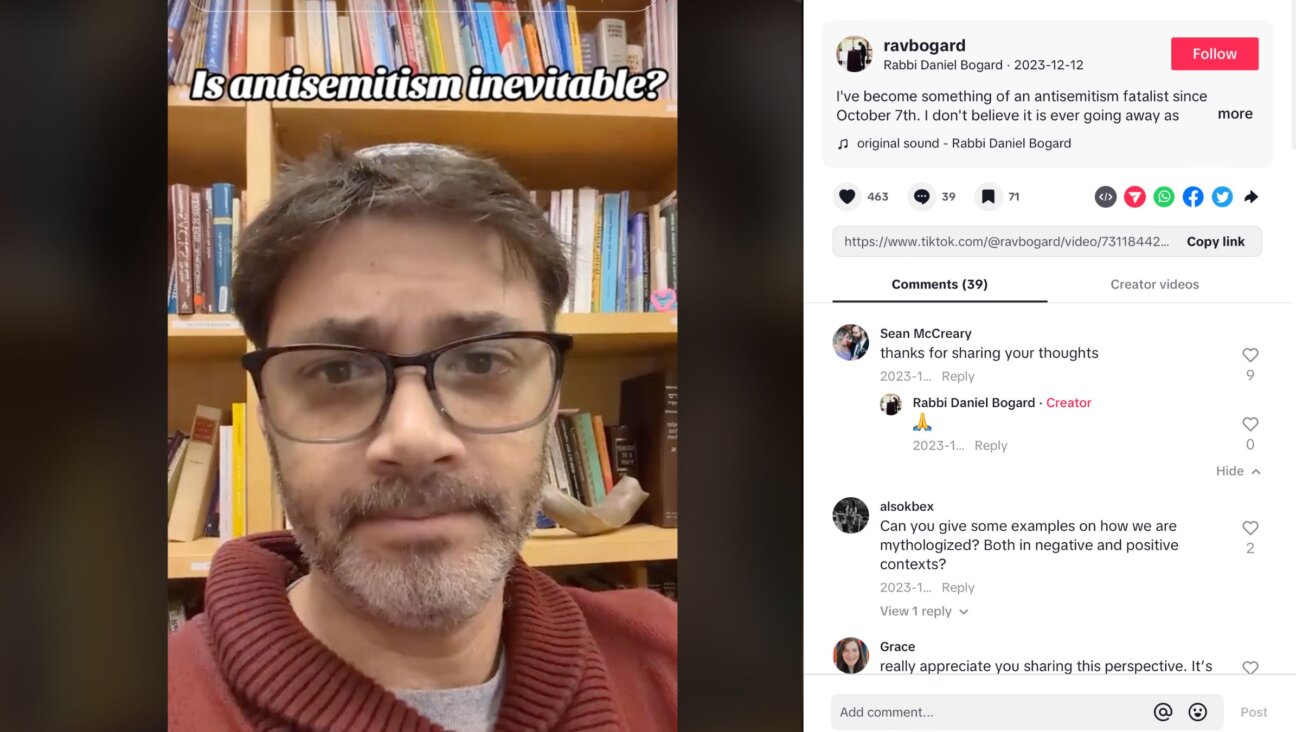Jewish Parents Once Panicked About Teens Joining Cults — But No Longer

Enlightenment: George Harrison of the Beatles poses with fellow Hare Krishnas. Image by Getty Images
In 1981, the New York Times wrote about a source of parental anguish that had been growing for about a decade. “From across the United States… American Jews face a special problem: a disproportionate number of their young are defecting to a proliferation of cults.”
The Moonies, Hare Krishnas, gurus, yogis — all of these loomed large and menacing back then.
I was in college in ’81, and while I didn’t have any friends who started shaking tambourines on street corners (well, the son of a family friend was, but that was it), cults were simply a part of the landscape. Walk through any airport and you were likely to be offered a flower by a blissed out Hare Krishna who just might’ve been your Camp Ramah counselor a few years earlier — or so it seemed.
A rabbi in the Times article said that while Jews represented 2.7% of the population, in some cults they made up 25-30% of the members. B’nai B’rith opened a cult awareness program in 1979. No wonder nice, middle-class parents were so scared!
And now — poof! — we’re not. I’ve got a son about to go off to college and it recently occurred to me that one worry I really don’t have is: What if he becomes a Moonie? (That’s the rather pejorative term for the followers of Rev. Sun Myung Moon, who created the South Korean Unification Church in 1954.)
So, how did this happen? How did the fear of cults grow so colossal only to go the way of macramé? Turns out, there is no simple answer.
“Denominational religion was caught flatfooted in the ’60s,” says Clark Strand, a Buddhist teacher, former Zen monk, and author of 2014’s “Waking the Buddha: How the Most Dynamic and Empowering Buddhist Movement in History is Changing our Concept of Religion.” As young people became disillusioned with almost all traditional power structures — government, education, and the military, of course — religion was not spared. Students went searching for alternatives, just as the gurus were springing up and ready to “enlighten” them. Hey, it worked for the Beatles.
“It’s like when you’re recently divorced, or recently come of age,” says Strand. “There was a kind of honeymoon phase with Asian religions. It was a time of infatuation with all things exotic and eastern. And when you’re infatuated you have a great deal of enthusiasm but not much reserve, so you get in over your head.”
Strand himself joined a Zen group at age 19 in 1977. He left 14 years later, at age 33.
Today’s kids may be less enthralled by NRMs or “New Religious Movements” (the politically correct name for cults) because they are less intrigued by religion, period, says Jim Atwood, an instructor of religion at Texas Christian University. “Texas Christian — we’ve got ‘Christian’ in our name!” he says. But, “we’ve got a whole lot [of the student body] that doesn’t self-identify as being part of any group.” He estimates up to a quarter of the students are “nones” — i.e., they would check “none of the above” if given a list of religious affiliations.
After all, thanks to the Internet, young people don’t have to join a cult to relieve their loneliness or find likeminded souls. They can simply log on. “If there’s no group they fit into at their high school, they’ll find one online,” notes cultural commentator Deb McAlister-Holland. What’s more, if anyone approaches them to join a group they haven’t heard of, they will Google it first. “This makes it harder for the cult leaders to hide the true nature of the experience facing them.”
But that doesn’t mean that today’s young people aren’t still searching. Many are. It’s just that, even when they find their spiritual answers in a different religion from their parents’, it no longer feels like they’ve been brainwashed. That’s because, like the hippies themselves, the cults have cleaned up their act.
At the height of the Hare Krishna movement, “there were about 5,000 full-time followers,” says Nori Muster — including her. The Hare Krishna movement was founded in New York City by the Calcutta-born religious leader Abhay Charanaravinda Bhaktivedanta Swami Prabhupada, in 1966. The group’s core beliefs are taken from certain traditional Hindu scriptures. Muster spent 10 years in the group and is the author of 2010’s “Cult Survivors Handbook: Seven Paths to an Authentic Life.” Hare Krishnas “were very visible because they went out and chanted. Now full-time members are probably down below 1,000 and they have a lot of members who don’t dress in the robes and shave their heads. They’re pretty much more plain clothes and they have regular jobs.” The same goes for many of the other once-fringe groups.
This mellowing has mellowed the societal response. B’nai B’rith closed its cult program in the late 1980s. “There are no statistical surveys I’ve seen. I can just give you my sense that those types of groups that were so popular in the ’70s are not as prevalent today,” says Rabbi Michael Skobac, director of education and counseling at the Canadian nonprofit Jews for Judaism, and a specialist in counter-missionary work. However, he adds, “Groups where people are going for personal growth and spiritual enlightenment — you’ll find a huge number of Jews in those groups.”
These entities seem less scary because they are simply part of the self-improvement marketplace. If a nice Jewish grad student goes on a Buddhist retreat, how different is that from her going to Thailand for vacation, or Italy for a cooking class? The food will be good, she’ll meet some new people, and she’ll come back refreshed, not re-programmed.
Long story short: Parents today probably don’t have to worry about finding their kids ohm-ing at O’Hare. But don’t expect them at shul on Saturday mornings, either. They’ve got their American-as-apple pie Bikram yoga class.
Lenore Skenazy is a public speaker and founder of the book and blog “Free-Range Kids.” Her show “World’s Worst Mom” airs on Discovery/TLC International.
















